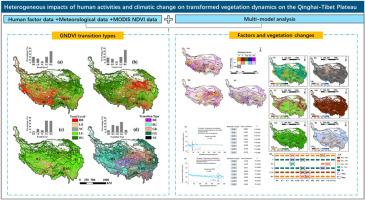人类活动和气候变化对青藏高原植被转化动态的非均质影响
IF 8.4
2区 环境科学与生态学
Q1 ENVIRONMENTAL SCIENCES
引用次数: 0
摘要
在全球环境变化加剧的背景下,阐明植被动态及其驱动机制对生态系统的可持续管理具有重要意义。青藏高原是一个以敏感性和脆弱性著称的地区,对气候变化和人类活动表现出高度的响应性。该地区明显的时空异质性使其成为研究植被变化及其驱动机制的最佳区域。然而,现有的研究以自然因素为主,缺乏对人类活动的系统分析,从而制约了对驱动机制的全面认识。利用MODIS NDVI数据,综合自然因子(温度、降水、潜在蒸散发、雪深、高程、坡度)和人为因子(道路、人口、放牧强度),从多尺度和植被类型角度,系统分析2000 - 2018年青藏高原生长季GNDVI变化趋势及其驱动机制。结果显示GNDVI (p <;(0.05),东北地区明显改善,西南和东南特定地区有所退化。2000 - 2018年,79.19%的QTP植被出现改善(39.52%显著改善),14.28%的植被出现退化(2.78%显著改善)。研究期间,青藏高原气候呈现增暖湿润趋势,总体上有利于植被生长。自然因素和人为因素对植被变化的影响在不同空间区域差异显著。人口密度和放牧强度对植被动态具有明显的阈值效应,当人口密度超过17 pop/km2时,其对植被变化率的影响接近边际效应,而放牧强度超过250 SU/km2时,GNDVI变化率显著下降。值得注意的是,公路和湖泊附近的放牧和旅游活动对西南部和东南部的GNDVI产生了负面影响,部分抵消了气候变化的积极影响,并加剧了退化。在此基础上,建议建立生态系统保护的长期投资机制,实施差别化区域管理策略,加强对人类活动的监管。具体而言,有必要严格控制生态敏感地区的放牧和旅游开发,以减轻其对脆弱生态系统的影响。该研究克服了传统方法的局限性,构建了一个整合自然和人为因素时空异质性的框架。该研究为高寒生态系统植被动态驱动机制的研究提供了理论依据,为制定差别化生态保护政策和可持续管理策略提供了科学依据。本文章由计算机程序翻译,如有差异,请以英文原文为准。

Heterogeneous impacts of human activities and climate change on transformed vegetation dynamics on the Qinghai-Tibet Plateau
In the context of intensifying global environmental change, elucidating vegetation dynamics and their driving mechanisms is vital for sustainable ecosystem management. The Qinghai-Tibet Plateau (QTP), a region known for its sensitivity and vulnerability, exhibits a high degree of responsiveness to climate change and human activities. The region's pronounced spatiotemporal heterogeneity renders it an optimal area for investigating vegetation changes and their driving mechanisms. However, existing research predominantly emphasizes natural factors, with insufficient systematic analysis of human activities, thereby constraining a comprehensive understanding of driving mechanisms. This study utilizes MODIS NDVI data to systematically analyze GNDVI (the average NDVI during the growing season) trends and their driving mechanisms across the QTP from 2000 to 2018, integrating natural factors (temperature, precipitation, potential evapotranspiration, snow depth, elevation, slope) and human factors (roads, population, grazing intensity) from multi-scale and vegetation-type perspectives. Results reveal a significant increasing trend in GNDVI (p < 0.05) across the QTP, with pronounced improvements in the northeast and degradation in specific regions of the southwest and southeast. From 2000 to 2018, 79.19% of QTP vegetation exhibited improvement (39.52% significantly), while 14.28% experienced degradation (2.78% significantly). During the study period, the QTP climate exhibited a warming and moistening trend, which generally benefited vegetation growth. The impacts of natural and human factors on vegetation changes vary significantly across different spatial regions. Population density and grazing intensity have obvious threshold effects on vegetation dynamics: when population density exceeds 17 pop/km2, their effects on vegetation change rate approach marginal effects, while grazing intensity exceeds 250 SU/km2, resulting in a significant decrease in GNDVI change rate. Notably, grazing and tourism activities near roads and lakes negatively impacted GNDVI in the southwest and southeast, partially offsetting the positive effects of climate change and contributing to degradation. Based on these findings, the study recommends establishing a long-term investment mechanism for ecosystem protection, implementing differentiated regional management strategies, and enhancing regulatory oversight of human activities. Specifically, strict controls on grazing and tourism development in ecologically sensitive areas are necessary to mitigate their impacts on fragile ecosystems. This study constructs a framework that integrates the spatiotemporal heterogeneity of natural and human factors, overcoming the limitations of traditional methods. It advances the theoretical understanding of the driving mechanisms behind vegetation dynamics in alpine ecosystems and provides a scientific foundation for formulating differentiated ecological protection policies and sustainable management strategies.
求助全文
通过发布文献求助,成功后即可免费获取论文全文。
去求助
来源期刊

Journal of Environmental Management
环境科学-环境科学
CiteScore
13.70
自引率
5.70%
发文量
2477
审稿时长
84 days
期刊介绍:
The Journal of Environmental Management is a journal for the publication of peer reviewed, original research for all aspects of management and the managed use of the environment, both natural and man-made.Critical review articles are also welcome; submission of these is strongly encouraged.
 求助内容:
求助内容: 应助结果提醒方式:
应助结果提醒方式:


